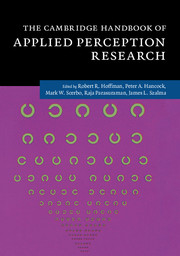Crossref Citations
This Book has been
cited by the following publications. This list is generated based on data provided by Crossref.
Morison, Alexander
and
Woods, David
2016.
Opening up the Black Box of Sensor Processing Algorithms through New Visualizations.
Informatics,
Vol. 3,
Issue. 3,
p.
16.
Busselle, Rick
2017.
The International Encyclopedia of Media Effects.
p.
1.
Harris, Kevin R.
Eccles, David W.
Freeman, Carlos
and
Ward, Paul
2017.
‘Gun! Gun! Gun!’: An exploration of law enforcement officers’ decision-making and coping under stress during actual events.
Ergonomics,
Vol. 60,
Issue. 8,
p.
1112.
Szalma, J. L.
Daly, T. N.
Teo, G. W. L.
Hancock, G. M.
and
Hancock, P. A.
2018.
Training for vigilance on the move: a video game-based paradigm for sustained attention.
Ergonomics,
Vol. 61,
Issue. 4,
p.
482.
Ursyn, Anna
2018.
Handbook of Research on Program Development and Assessment Methodologies in K-20 Education.
p.
478.
Ursyn, Anna
2018.
Visual Approaches to Cognitive Education With Technology Integration.
p.
164.
Hancock, P. A.
and
Szalma, James L.
2019.
Sustained Attention to Science: A Tribute to the Life and Scholarship of Joel Warm.
Human Factors: The Journal of the Human Factors and Ergonomics Society,
Vol. 61,
Issue. 3,
p.
365.
Al-Shargie, Fares
Tariq, Usman
Hassanin, Omnia
Mir, Hasan
Babiloni, Fabio
and
Al-Nashash, Hasan
2019.
Brain Connectivity Analysis Under Semantic Vigilance and Enhanced Mental States.
Brain Sciences,
Vol. 9,
Issue. 12,
p.
363.
Kettwich, Carmen
Schrank, Andreas
and
Oehl, Michael
2021.
Teleoperation of Highly Automated Vehicles in Public Transport: User-Centered Design of a Human-Machine Interface for Remote-Operation and Its Expert Usability Evaluation.
Multimodal Technologies and Interaction,
Vol. 5,
Issue. 5,
p.
26.
Vlahovic, Sara
Suznjevic, Mirko
and
Skorin-Kapov, Lea
2022.
A Framework for the Classification and Evaluation of Game Mechanics for Virtual Reality Games.
Electronics,
Vol. 11,
Issue. 18,
p.
2946.
Moesl, Birgit
Schaffernak, Harald
Vorraber, Wolfgang
Braunstingl, Reinhard
and
Koglbauer, Ioana Victoria
2023.
Performance, Emotion, Presence: Investigation of an Augmented Reality-Supported Concept for Flight Training.
Applied Sciences,
Vol. 13,
Issue. 20,
p.
11346.
Nicolosi, Simona
Quinto, Antonella
Lipoma, Mario
and
Sgrò, Francesco
2023.
Situational Analysis and Tactical Decision-Making in Elite Handball Players.
Applied Sciences,
Vol. 13,
Issue. 15,
p.
8920.



